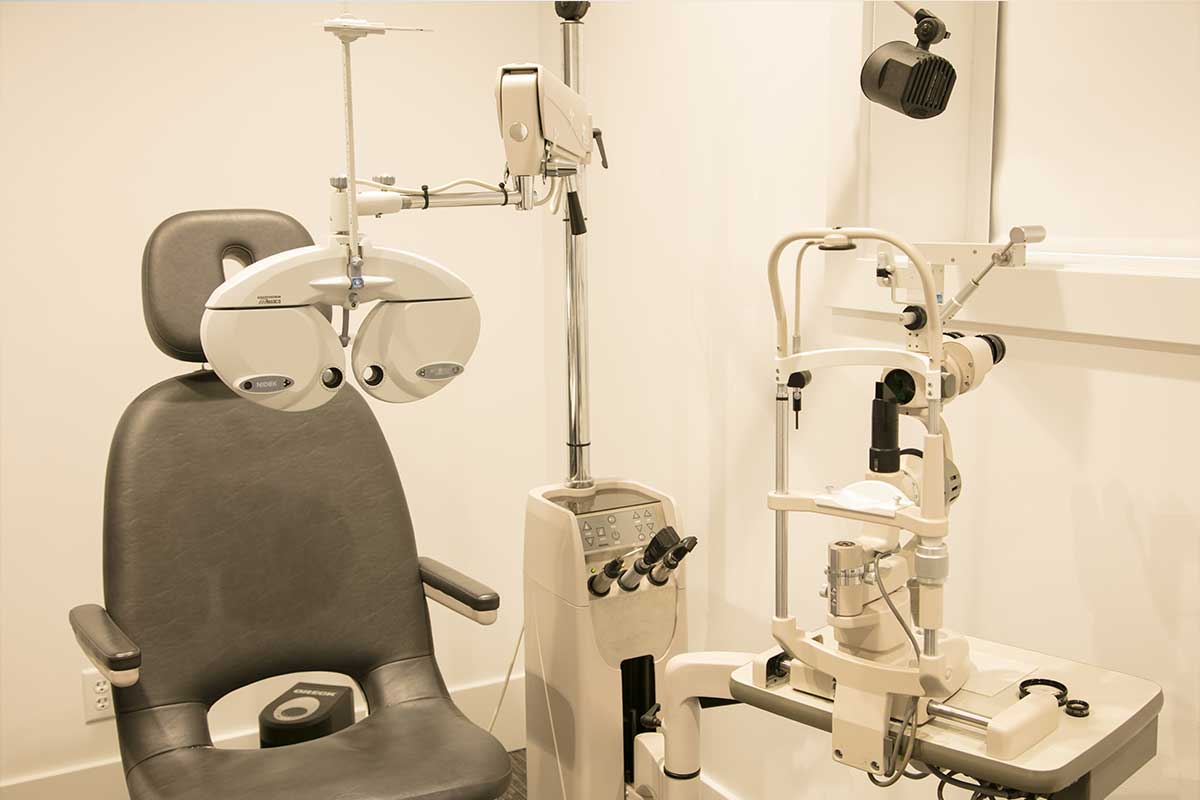Fighting The Drain Of Digital Eye Strain

Every year, more than ten million patients visit eye doctors for problems related to digital eye strain.
It doesn’t take much to produce digital eye strain—as little as two hours in front of a computer per day gives you a 90 percent chance to develop it. This makes it the single most common complaint related to computer use.
That raises the question: does this widespread condition have an impact on our work productivity? We know many of our patients have jobs that require them to look at a computer screen for far longer than two hours per day, so we took a closer look at this issue.
Symptoms Of Digital Eye Strain
Eye fatigue is by far one of the most common symptoms of digital eye strain, but you may be surprised to learn some of the other effects we experience from prolonged screen exposure, including:
-
- Headaches
- Neck and shoulder pain
- Eye irritation
- Itching or burning eyes
- Back pain
- Blurred vision
- General fatigue
- Tearing
Effects Of Digital Eye Strain On Our Work
To answer that initial question, then, the discomfort and fatigue of digital eye strain does indeed impact our productivity at work. In fact, it can lead to a 20 percent drain on productivity. So if you’re having trouble keeping up with your computer workload, working longer might not be as effective a solution as minimizing eye strain so that you can make the most out of your regular hours.
Fighting The Strain
If you have a full-time job and most of it involves staring at a computer screen, it might seem like digital eye strain is inevitable and unavoidable. However, there are things you can do to minimize the symptoms, if not completely get rid of them.
Follow the 20-20-20 Rule
Taking regular breaks can go a long way towards keeping your eyes from tiring out. Every twenty minutes, spend twenty seconds looking at something twenty feet away before looking back at your screen. You could schedule reminders until this becomes habit.
Posture And Desk Arrangement
It will be more comfortable to look at your screen if it is slightly below eye level and angled up. It should also be no closer than twenty inches from your face. Also, when using reference materials, try to position them so that you don’t have to move your head when glancing between them and the screen.
To learn a bit more about arranging your work space to avoid eye strain, watch the video below:
[iframe https://www.youtube.com/embed/wyVc37ykstU?rel=0&start=135&end=222 620 349]
Avoid Glare
Angle your screen so that you don’t have to squint through glare from the overhead lighting or windows to see your work. If there’s no glare-free angle, a screen glare filter is another great option.
Wear Computer Glasses
Like UV-blocking sunglasses protect our eyes from the sun, computer glasses protect our eyes from the strain of staring at computer screens. They reduce glare and increase contrast, making it easier to look at screens for longer periods of time. However, computer glasses can alter the colors you see, which means they probably aren’t the best eye strain solution for graphic designers or others in artistic fields.
Help Us Help Your Eyes!
If you’ve been suffering from any of the symptoms of digital eye strain or if the above methods aren’t relieving your eye strain enough, give us a call and schedule an eye exam. There’s no need to continue suffering in silence when healthier eyes and increased work productivity are easily within reach.
We’re your best resource for overall eye health, not just lens prescriptions!
Top image used under CC0 Public Domain license. Image cropped and modified from original.
The content on this blog is not intended to be a substitute for professional medical advice, diagnosis, or treatment. Always seek the advice of qualified health providers with questions you may have regarding medical conditions.
Fighting The Drain Of Digital Eye Strain

Every year, more than ten million patients visit eye doctors for problems related to digital eye strain.
It doesn’t take much to produce digital eye strain—as little as two hours in front of a computer per day gives you a 90 percent chance to develop it. This makes it the single most common complaint related to computer use.
That raises the question: does this widespread condition have an impact on our work productivity? We know many of our patients have jobs that require them to look at a computer screen for far longer than two hours per day, so we took a closer look at this issue.
Symptoms Of Digital Eye Strain
Eye fatigue is by far one of the most common symptoms of digital eye strain, but you may be surprised to learn some of the other effects we experience from prolonged screen exposure, including:
-
- Headaches
- Neck and shoulder pain
- Eye irritation
- Itching or burning eyes
- Back pain
- Blurred vision
- General fatigue
- Tearing
Effects Of Digital Eye Strain On Our Work
To answer that initial question, then, the discomfort and fatigue of digital eye strain does indeed impact our productivity at work. In fact, it can lead to a 20 percent drain on productivity. So if you’re having trouble keeping up with your computer workload, working longer might not be as effective a solution as minimizing eye strain so that you can make the most out of your regular hours.
Fighting The Strain
If you have a full-time job and most of it involves staring at a computer screen, it might seem like digital eye strain is inevitable and unavoidable. However, there are things you can do to minimize the symptoms, if not completely get rid of them.
Follow the 20-20-20 Rule
Taking regular breaks can go a long way towards keeping your eyes from tiring out. Every twenty minutes, spend twenty seconds looking at something twenty feet away before looking back at your screen. You could schedule reminders until this becomes habit.
Posture And Desk Arrangement
It will be more comfortable to look at your screen if it is slightly below eye level and angled up. It should also be no closer than twenty inches from your face. Also, when using reference materials, try to position them so that you don’t have to move your head when glancing between them and the screen.
To learn a bit more about arranging your work space to avoid eye strain, watch the video below:
[iframe https://www.youtube.com/embed/wyVc37ykstU?rel=0&start=135&end=222 620 349]
Avoid Glare
Angle your screen so that you don’t have to squint through glare from the overhead lighting or windows to see your work. If there’s no glare-free angle, a screen glare filter is another great option.
Wear Computer Glasses
Like UV-blocking sunglasses protect our eyes from the sun, computer glasses protect our eyes from the strain of staring at computer screens. They reduce glare and increase contrast, making it easier to look at screens for longer periods of time. However, computer glasses can alter the colors you see, which means they probably aren’t the best eye strain solution for graphic designers or others in artistic fields.
Help Us Help Your Eyes!
If you’ve been suffering from any of the symptoms of digital eye strain or if the above methods aren’t relieving your eye strain enough, give us a call and schedule an eye exam. There’s no need to continue suffering in silence when healthier eyes and increased work productivity are easily within reach.
We’re your best resource for overall eye health, not just lens prescriptions!
Top image used under CC0 Public Domain license. Image cropped and modified from original.
The content on this blog is not intended to be a substitute for professional medical advice, diagnosis, or treatment. Always seek the advice of qualified health providers with questions you may have regarding medical conditions.
Fighting The Drain Of Digital Eye Strain

Every year, more than ten million patients visit eye doctors for problems related to digital eye strain.
It doesn’t take much to produce digital eye strain—as little as two hours in front of a computer per day gives you a 90 percent chance to develop it. This makes it the single most common complaint related to computer use.
That raises the question: does this widespread condition have an impact on our work productivity? We know many of our patients have jobs that require them to look at a computer screen for far longer than two hours per day, so we took a closer look at this issue.
Symptoms Of Digital Eye Strain
Eye fatigue is by far one of the most common symptoms of digital eye strain, but you may be surprised to learn some of the other effects we experience from prolonged screen exposure, including:
-
- Headaches
- Neck and shoulder pain
- Eye irritation
- Itching or burning eyes
- Back pain
- Blurred vision
- General fatigue
- Tearing
Effects Of Digital Eye Strain On Our Work
To answer that initial question, then, the discomfort and fatigue of digital eye strain does indeed impact our productivity at work. In fact, it can lead to a 20 percent drain on productivity. So if you’re having trouble keeping up with your computer workload, working longer might not be as effective a solution as minimizing eye strain so that you can make the most out of your regular hours.
Fighting The Strain
If you have a full-time job and most of it involves staring at a computer screen, it might seem like digital eye strain is inevitable and unavoidable. However, there are things you can do to minimize the symptoms, if not completely get rid of them.
Follow the 20-20-20 Rule
Taking regular breaks can go a long way towards keeping your eyes from tiring out. Every twenty minutes, spend twenty seconds looking at something twenty feet away before looking back at your screen. You could schedule reminders until this becomes habit.
Posture And Desk Arrangement
It will be more comfortable to look at your screen if it is slightly below eye level and angled up. It should also be no closer than twenty inches from your face. Also, when using reference materials, try to position them so that you don’t have to move your head when glancing between them and the screen.
To learn a bit more about arranging your work space to avoid eye strain, watch the video below:
[iframe https://www.youtube.com/embed/wyVc37ykstU?rel=0&start=135&end=222 620 349]
Avoid Glare
Angle your screen so that you don’t have to squint through glare from the overhead lighting or windows to see your work. If there’s no glare-free angle, a screen glare filter is another great option.
Wear Computer Glasses
Like UV-blocking sunglasses protect our eyes from the sun, computer glasses protect our eyes from the strain of staring at computer screens. They reduce glare and increase contrast, making it easier to look at screens for longer periods of time. However, computer glasses can alter the colors you see, which means they probably aren’t the best eye strain solution for graphic designers or others in artistic fields.
Help Us Help Your Eyes!
If you’ve been suffering from any of the symptoms of digital eye strain or if the above methods aren’t relieving your eye strain enough, give us a call and schedule an eye exam. There’s no need to continue suffering in silence when healthier eyes and increased work productivity are easily within reach.





